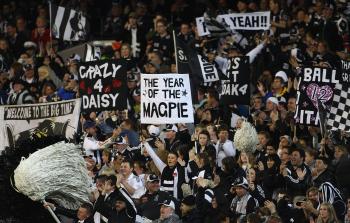[xtypo_dropcap]M[/xtypo_dropcap]ELBOURNE, Australia—A simple form guide is impossible to imagine. With endless talking points to the tribal rivalry between this year’s AFL Grand Finalists, Collingwood Magpies and St Kilda Saints, where so much can go either way, sometimes a match can come down to luck. Anything can go wrong on the day.
Leading into the match, every piece of numerology, for those inclined, will be considered as to who the gods will favour.
Every turnover. Every mistake. Every umpire’s, player’s and coaches’ choice. Every player carrying a niggle or under an injury cloud coming into the match. Every heroic act as 36 players physically pit their bodies, while following rules that are sometimes greyer than a winter’s day in Melbourne. Every piece of luck. Everything will be scrutinised from around the world. Meanwhile, as the action on the Melbourne Cricket Ground will be under the microscope, so is Melbourne. It’s not new. It happens every year at this time.
St Kilda made it to this stage last year. That time it was to narrowly lose in the dying time-on phase of the match against the Geelong Cats. The battle was epic.
That’s the way the Saints play in any match against the power teams these days.
This time they will be facing a raging red-hot Pies team who clearly finished on top of the ladder and finished the lopsided season with 16-teams in a 22 Round home-and-away season. St Kilda was third.
Leading into the match, every piece of numerology, for those inclined, will be considered as to who the gods will favour.
Every turnover. Every mistake. Every umpire’s, player’s and coaches’ choice. Every player carrying a niggle or under an injury cloud coming into the match. Every heroic act as 36 players physically pit their bodies, while following rules that are sometimes greyer than a winter’s day in Melbourne. Every piece of luck. Everything will be scrutinised from around the world. Meanwhile, as the action on the Melbourne Cricket Ground will be under the microscope, so is Melbourne. It’s not new. It happens every year at this time.
St Kilda made it to this stage last year. That time it was to narrowly lose in the dying time-on phase of the match against the Geelong Cats. The battle was epic.
That’s the way the Saints play in any match against the power teams these days.
This time they will be facing a raging red-hot Pies team who clearly finished on top of the ladder and finished the lopsided season with 16-teams in a 22 Round home-and-away season. St Kilda was third.






